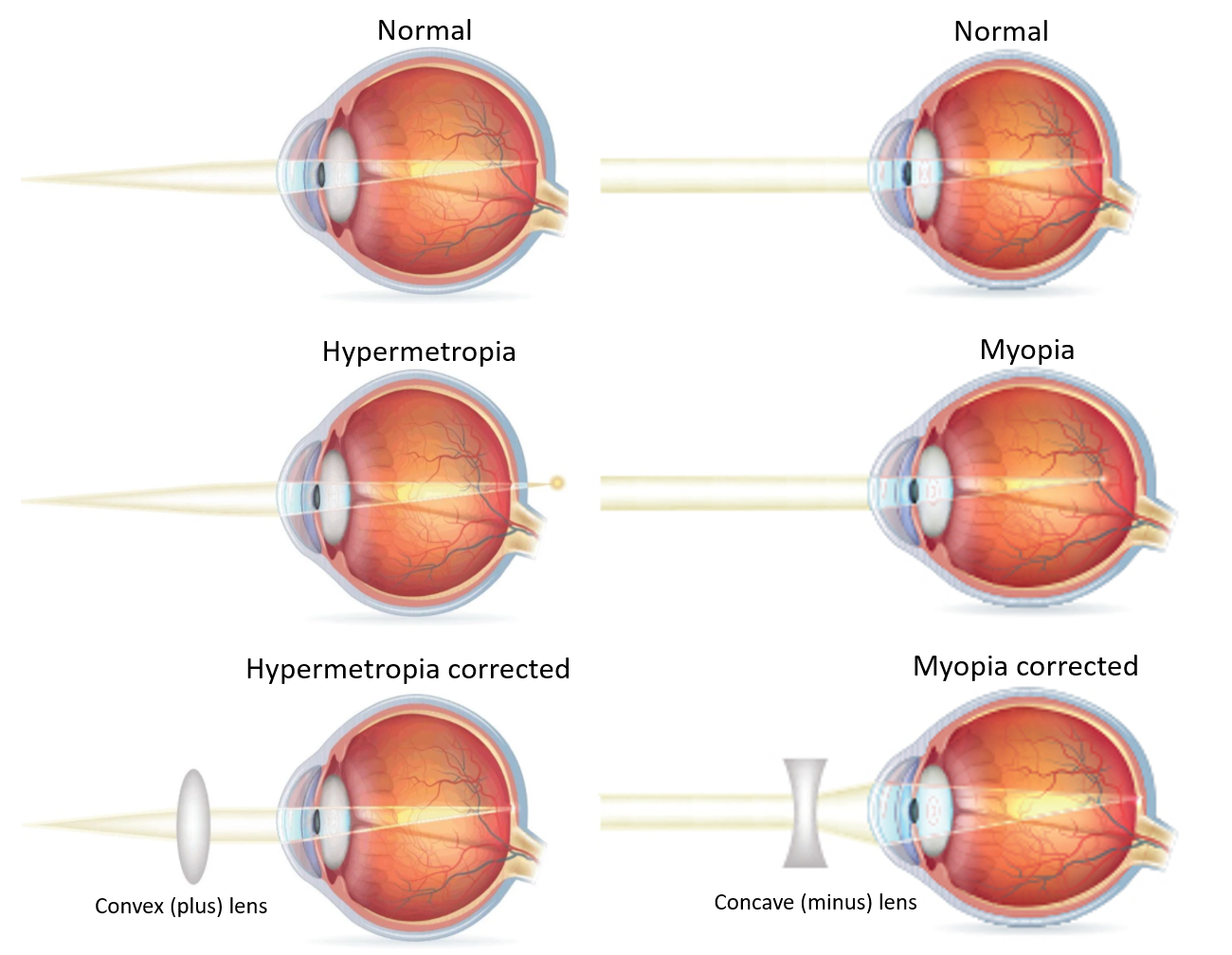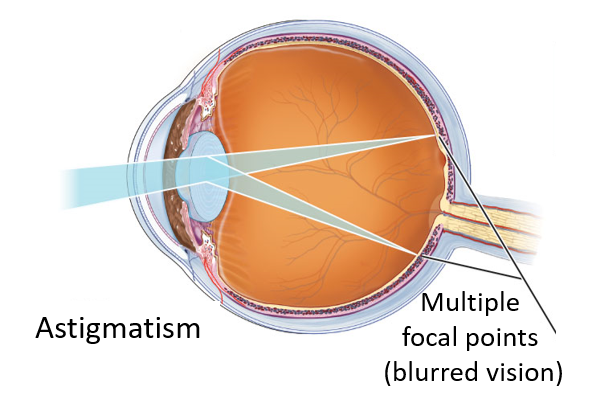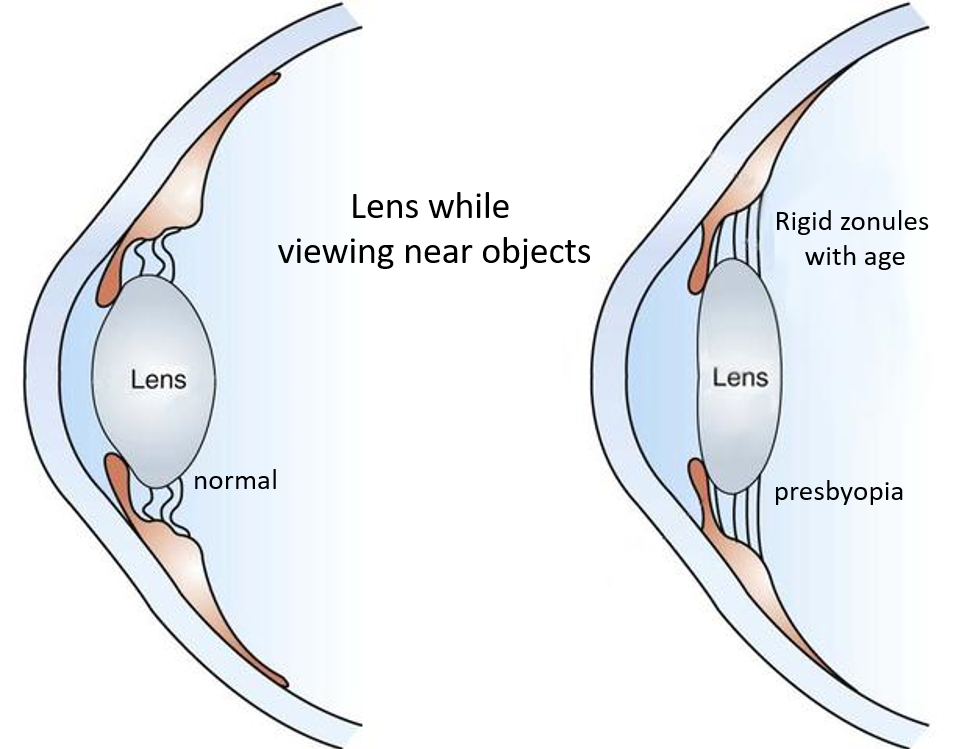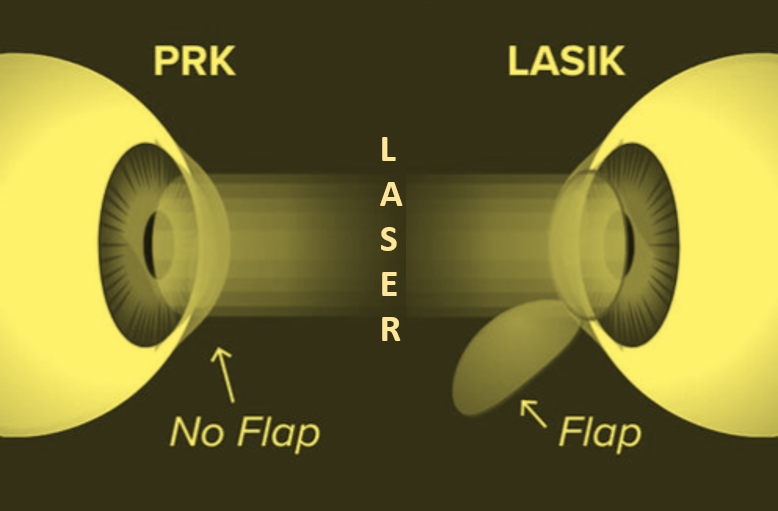WHAT ARE REFRACTIVE ERRORS
The presence of spectacle number for distance and/or near is called a refractive error. It is the most common cause of reduction in vision.
SYMPTOMS OF REFRACTIVE ERRORS
- Feeling eye strain or blurring more after screen work, reading, or at the end of the day
- Headaches, that are worse at the end of the day and typically felt at the lower part of the forehead and brow.
- Inability to read fine text or recognize details of objects or faces from far
- Need to pinch the eyes half shut to see far objects and text more clearly
- Move near objects or texts away for better clarity
Getting a vision test and prescription for glasses from an optometrist/ophthalmologist restores visual clarity and removes eye strain symptoms. A thorough eye examination should be done by an ophthalmologist to rule out any eye disease or condition.
TYPES OF REFRACTIVE ERRORS
Refraction is the process by which the light rays from an object are converged by the cornea and the lens of the eye to form a clear image on the retina (back curtain of the eye). This image is carried by the optic nerve to the visual area of the brain where it is interpreted.
Myopia
If the cornea is steeper than normal, it will over-converge the light rays, and the image will be formed in front of the retina and appear blurred. This is called myopia. As the convergence of light rays is more, the farther the object, in myopia, distance objects appear blurred while near objects are clear (shortsightedness). Therefore this condition is corrected by a spherical concave (diverging) lens in the spectacle and the person is said to have a minus number.
Hypermetropia
If the cornea is flatter than normal, it will under-converge the light rays, and the image will be formed behind the retina and appear blurred. This is called hypermetropia or hyperopia. As the convergence of light rays is more, the farther the object, in hyperopia, distance objects appear more clear while near objects are more blurred (longsightedness). Therefore this condition is corrected by a spherical convex (converging) lens in the spectacle and the person is said to have a plus number.

Astigmatism
Sometimes the cornea may not be uniformly steep or flat and may be steep in one direction (axis) and flat in the direction perpendicular to the steep axis. This kind of refractive error is called astigmatism. It will require a spherical concave or convex lens, with an additional correction along the particlular axis with a cylindrical lens. So while a spherical lens just has a plus or minus number, a cylindrical lens will also mention an axis in degrees.



Presbyopia
This is a refractive error that occurs not because of the cornea but due to the lens of the eye. With increasing age, the ability of accommodation (the ability of the lens to become more convex to converge near objects) reduces due to increasing rigidity of the ciliary muscle of the lens, which is called presbyopia. In such cases, reading and all near work becomes difficult, and the person has to move the object or text away from the usual reading/near work point, to see clearer. This condition is treated with plus convex lenses which need to be only worn for near work (glasses/ add-on number for reading).
Those who have hypermetropia or myopia can also develop presbyopia with age. There are bifocal glasses where the upper part is corrected for their myopic or hyperopic number and the lower part with the add-on presbyopic correction. Varifocal or progressive glasses have corrections for multiple distances, mainly distance, intermediate and near, and help those who use laptops and computers regularly.



SPECTACLE VERSUS CONTACT LENSES
While spectacles are the most common way of correcting refractive errors, they are not always the most cosmetic choice.
Spectacles (Glasses)
They are easy to put on and take off, don’t need special cleaning solutions, and can also offer protection from UV radiation, and be scratch-proof. They can be mineral glass or organic glass (plastic), the latter being preferred due to being lighter, more resistant to scratches and impact, and easier to apply coatings. Spectacle frames can be made from a variety of materials, including stainless steel, monel, plastic, propionate, and nylon, which are all lightweight and durable. However, spectacles present problems in certain professions like sports and modeling. Glasses with high spherical/cylindrical numbers or those with more than 3D difference between the 2 eyes, can lead to distortion of vision.
Contact lenses
They conform to the curvature of your eye, provide a wider field of vision, and therefore give better quality of vision, especially in higher and asymmetric numbers between the eyes. Contact lenses may be:
- Soft – Made from hydrogels of hydroxyethyl methacrylate or silicone, these lenses are water-based and soften when hydrated with water or lens solution. These may be daily/monthly disposable or annual wear depending on the softness and water content.
- Rigid – These are of two types. Rigid gas permeable (RGP) are made from silicon and cellulose acetate butyrate, and these lenses are rigid and can offer crisper vision. They are a good option for people with irregular corneas or keratoconus (centrally cone-shaped cornea) and can be more durable than soft lenses.Rigid non-gas permeable.
Contact lenses that offer cylindrical correction are called toric lenses.
Contact lenses require much more care than glasses in terms of removing and putting in solution, and periodic cleaning. They can sometimes get chipped or if removed with sharp nails carelessly can cause corneal abrasions. Prolonged hours of wear can cause dry eyes, tiredness, redness of the eyes, and mild haziness of vision. Sometimes one can get serious eye infections (corneal ulcers, keratitis) if not cleaned well or inserted properly.
EYEDROPS
Recently a drug called pilocarpine as a 1,25% eyedrop has been approved for prebyopia. The drug constricts the pupil and causes ciliary muscle to contract therefore making the lens more convex. However, the effect of the drop lasts for about 4-6 hours, so could be used during a meeting, presentation, important social event, or during intricate near work like surgery, craft, electronics, etc. This eyedrop may not be a complete replacement for reading glasses as drops have to be instilled multiple times a day, and can sometimes cause eye irritation, redness, and inflammation.
SURGICAL CORRECTION OF REFRACTIVE ERRORS
- Laser-assisted in situ keratomileusis (LASIK) is the most commonly performed eye laser surgery and involves creating a partial-thickness corneal flap and using an excimer laser to reshape the cornea. The flap is then placed back into its original position. Discomfort after surgery is minimal, and vision recovery usually takes place in 1 to 2 days.
- Photorefractive keratectomy (PRK), removes the top surface (corneal epithelium), rather than creating a flap. This corneal abrasion takes 3 to 4 days to heal, resulting in mild to moderate pain and blurred vision in the short term. Visual recovery takes longer in PRK, so LASIK is always the first choice procedure while PRK may be considered in those with very thin corneas, where flap creation may be difficult or in those with high risk of contact injury which may sometimes disclocate the corneal flap.



- Small-incision lenticule extraction (SMILE). This newer type of refractive surgery reshapes the cornea by using a laser to make a lens-shaped bit of tissue, called a lenticule, below the cornea surface. Once the lenticule is created, it is removed through a small incision, thus changing the shape of the cornea.
- Intraocular lenses. Corrective lenses can be surgically inserted in the eye to improve vision. These intraocular lenses are routinely inserted as part of cataract surgery, especially in the elderly. Younger people with high degrees of nearsightedness that cannot be satisfactorily treated with corrective lenses also may be rarely offered intraocular lenses.
- Intraocular Collamer Lenses (ICLs) are soft polymer and collagen intraocular lenses that sit behind the iris but in front of the lens. It has the advantage of treating higher levels of astigmatism and myopia. However, it has downsides of early cataract formation and risk of glaucoma.
- Bioptics combines one or more techniques, such as intraocular lenses and LASIK to treat myopia and hypermetropia.
Also read:
Vision Reduction and Loss – Understanding Causes and Points for Timely Action
Laptop and Computer use – solutions to reduce adverse health impact

